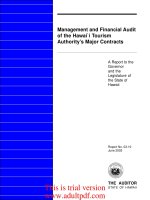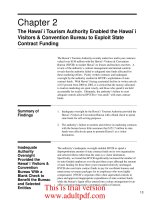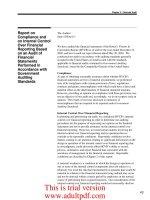Management and Financial Audit of the Hawaii Tourism Authority’s Major Contracts A Report _part4 doc
Bạn đang xem bản rút gọn của tài liệu. Xem và tải ngay bản đầy đủ của tài liệu tại đây (44.12 KB, 10 trang )
23
Chapter 2: The Hawai`i Tourism Authority Enabled the Hawai`i Visitors & Convention Bureau to Exploit State Contract Funding
circumvent the return of funds to the authority. We found that this
practice of spending exactly up to its limit existed for the duration of the
bureau’s leisure contract with the authority.
However, it should be noted that the scope of our financial audit
primarily focused on the calendar year ending December 31, 2002.
Although HVCB conducted its own financial audit for the same period,
the State and the Legislature should take additional steps to satisfy
themselves that the practice that led to our consultant's qualified opinion
did not happen in previous years or under the meetings, conventions and
incentives contract. We strongly believe that HVCB's practice of
committing funds to pay for future goods and services warrants re-
examination.
HVCB generally procures goods or services from third-party vendors
(subcontractors) in three ways: (1) a formal contract issued by HVCB;
(2) an agreement for services, which is generally issued by the vendor
and which may include a proposal; or (3) purchases for food and
beverages that do not require proposals. Although HVCB expends a
significant amount of its funds on these contracts, agreements, and
purchases, we found HVCB’s administration and management of them
deficient.
Procurement policies and procedures were inadequate and HVCB did not
adhere to those that were in place. HVCB failed to adequately and
consistently document its contract monitoring and evaluation efforts.
Instead, HVCB tended to rely on personal relationships and oral
communications as evaluation tools. We also found that HVCB did not
execute contracts in a timely manner and that procured services were
sometimes beyond the scope of the bureau’s leisure contract. Moreover,
the bureau expended state contract funds for legal services to develop
and advocate positions detrimental to the authority. Finally, HVCB’s
contract files were incomplete and disorganized.
The process by which subcontracts are procured, monitored,
and evaluated is inconsistent
HVCB’s current procurement policies and procedures indicate the
procedures for issuing requests for proposals and quotations, but are
silent as to when these requests should be issued. As a result, we found
instances where HVCB procured goods or services using significant
amounts of state funds without written contracts or agreements
specifying the goods or services to be provided.
For example, although HVCB paid one vendor $2 million for advertising
services during CY2002, there was no written agreement as to the type
HVCB’s poor contract
management results in
substandard oversight
of its state-funded
subcontractors
This is trial version
www.adultpdf.com
24
Chapter 2: The Hawai`i Tourism Authority Enabled the Hawai`i Visitors & Convention Bureau to Exploit State Contract Funding
and scope of services the vendor would provide and the payment terms.
Another vendor was paid about $700,000 during CY2002; however, we
found only a proposal that described some of the services the vendor
ultimately provided. Although we found invoices from these vendors,
the invoices served as after-the-fact documents of the goods or services
that had already been provided. Prudent business practice dictates that a
contract or agreement should be in place, specifying HVCB’s
requirements and expectations in order to protect its and the State’s
interests.
Although HVCB has written policies and procedures governing
contractor evaluations, they do not provide guidelines on documenting
the evaluations. We reviewed 25 contracts and noted that HVCB did not
document its evaluation of contractor performance for 23 of them. We
found that the need for contract evaluations and reports is determined by
each contract and on a case-by-case basis.
For example, HVCB had a three-year contract with an advertising firm to
provide state-funded marketing and advertising services for a $36,000
monthly fee. The advertising firm was also eligible for bonus payments
if it met certain goals. The contract’s value over the three years was
approximately $1.3 million. However, HVCB has never formally
evaluated this advertising firm. According to HVCB, it never conducted
a formal evaluation because it is in constant contact with the firm.
HVCB explained that its “informal” evaluation system consisted of
status meetings on important projects and periodic written and verbal
progress reports by the firm. HVCB also remarked that its vice president
of North America has a personal relationship with the firm’s chief
executive officer and that the relationship is built on trust, teamwork, and
project fulfillment.
We disagree with HVCB’s evaluation methods. While strong
relationships with its vendors are important, the lack of formal reporting
requirements and contract evaluations means that HVCB is without a
mechanism to assess its contractors’ performance objectively and to
ensure that state contract funds were used efficiently and effectively. In
addition, formally documenting that contract expenditures have been
monitored provides assurance that costs being incurred agree with
contract terms. Documenting contractor performance evaluation is
necessary to ensure that the contracts were evaluated according to HVCB
guidelines and serves as a basis for determining whether to terminate or
renew the contracts.
Contracts were not executed in a timely manner
HVCB does not always execute contracts prior to the commencement of
work. Our review of a sample of 25 contracts found that 11 were
This is trial version
www.adultpdf.com
25
Chapter 2: The Hawai`i Tourism Authority Enabled the Hawai`i Visitors & Convention Bureau to Exploit State Contract Funding
executed after services were scheduled to commence. In five of the 11
instances, contracts were signed more than one year after the start date of
the services. We were unable to determine when five contracts or
agreements were executed because the signatory date was blank. Finally,
all necessary HVCB representatives did not sign two of the contracts as
required by HVCB policy.
Most of the 11 vendors provided services before contracts were finalized
because they had previous contracts or agreements with HVCB and
expected the continuation of those contracts and agreements. However,
this is not in the best interest of the vendors or the authority.
Some subcontractors were procured to perform state-funded
services beyond the scope of the bureau’s leisure contract
Under HVCB’s leisure contract with the authority, HVCB must make
every effort to obtain the authority’s prior written approval before it
engages in projects or programs that will exceed the duration of its
contract and are not included in the annual tourism marketing plan. We
found at least two occasions where HVCB entered into contracts that
exceeded the scope of its contract with the authority. First, HVCB
entered into a three-year agreement with Buena Vista Disney to promote
the animated movie Lilo & Stitch. The contract was effective from April
15, 2002 through April 14, 2005. However, HVCB’s contract with the
authority ended on December 31, 2002. In effect, HVCB committed
$2.2 million in state contract funds that it did not have.
The second instance of HVCB entering into a contract beyond the term
of its contract with the authority is a contract with Wish (Wei-Yuan)
Company, a Taiwan public relations company. Moreover, the
circumstances surrounding the awarding of this contract suggest self-
dealing or at least a conflict of interest. Specifically, on the same day
that the Wish Company contract was awarded, the president of Wish
Company signed a separation agreement with HVCB as its vice president
for developing international markets.
Under the contract, Wish Company serves as HVCB’s worldwide
representative in Taiwan by promoting Hawai‘i in Taiwan and improving
and maintaining the image of Hawai`i in Taiwan as a primary visitor and
convention/incentive destination. The contract was originally effective
from May 1, 2002 through December 31, 2005 and committed a total of
$242,000 in state contract funds ($44,000 for CY2002, $66,000 for
CY2003, $66,000 for CY2004, and $66,000 for CY2005).
On April 30, 2002, just days prior to the execution of the contract, the
former HVCB vice president resigned from her HVCB position to
“pursue employment elsewhere.” Three days later, on May 3, 2002,
This is trial version
www.adultpdf.com
26
Chapter 2: The Hawai`i Tourism Authority Enabled the Hawai`i Visitors & Convention Bureau to Exploit State Contract Funding
HVCB executed the contract with the former vice president’s company
to provide worldwide representative services. At the time the contracts
were signed, the former HVCB vice president was Wish Company’s
president.
The former HVCB vice president’s Wish Company not only won the
contract award, but also received a contract with an end date extending
past 2002. We note, however, that HVCB recently changed the
contract’s end date to December 31, 2003—the last day of the bureau’s
extended contract with the authority.
Legal services provided by a state-funded subcontractor
sought to undermine state interests
In CY2002, HVCB paid a law firm a total of $300,596 for legal services
with state funds intended to market Hawai‘i. Moreover, our review of
billing statements from the law firm revealed that on several occasions
the law firm was engaged to advocate a position adverse to the authority
and the State.
For example, the law firm conducted extensive work for HVCB during
the 2002 legislative session that included research, bill tracking, drafting
testimony, and committee hearing monitoring. One billing entry by the
law firm noted that it did work to “review/revise/finalize memo re HB
2451 veto issues.” The bill, which was referenced HB 2451, provided
the authority with the right to market, operate, manage, and maintain the
Hawai`i Convention Center. In addition, the bill provided that
convention center management would also include marketing the facility.
Public testimony indicated that the authority supported this legislation.
Thus, HVCB used state contract funds received from the authority to
develop and advocate a position contrary to that of the authority. We
question the propriety of utilizing state funds intended to market Hawai`i
for legal services designed to undermine the authority.
On a separate occasion, HVCB received state contract funds from the
authority to conduct legal research regarding the authority’s attendance
at HVCB board of directors and marketing advisory committee meetings.
Under the terms of the leisure contract, the authority was empowered to
attend all such meetings and to receive advance notices of these meetings
from HVCB.
Billing statements from HVCB’s state-funded attorney revealed that the
attorney responded to an e-mail from an HVCB executive “questioning
the prudence of HTA member attending meetings.” While researching
the legality of the authority’s attendance may have been legitimate, we
again question the appropriateness of using state funds for this purpose.
This is trial version
www.adultpdf.com
27
Chapter 2: The Hawai`i Tourism Authority Enabled the Hawai`i Visitors & Convention Bureau to Exploit State Contract Funding
Other billing entries reviewed read, “review and respond to email
regarding strategy for killing SB 3017.” Still others requested analysis
of campaign finance/public ethics law issues as they relate to dues for a
particular political candidate, research regarding gifts of travel to public
officials, state ethics law issues, and drafting HVCB testimony for a city
council meeting. Even if these are legitimate legal issues facing HVCB,
HVCB is not justified in expending over $300,000 in state contract funds
for purposes that do not contribute to marketing Hawai`i as a visitor
destination.
Contract files are disorganized and incomplete
HVCB’s written policies and procedures for bids, quotes, and contracts
state that original contracts or copies of contracts for island chapters’
contracts are to be centrally filed. Although HVCB employees are aware
that contract amendments are an integral part of contracts, we found that
contract amendments were not always centrally filed. Instead, HVCB
department directors or managers sometimes retained documentation of
contract amendments instead of filing the amendments with the original
contracts. By filing pertinent contract documents in different locations,
HVCB is unable to efficiently research specific contracts and agreements
with third parties or be certain whether any amendments were made.
We also found that HVCB does not assign sequential contract numbers.
As a general business practice, organizations that manage numerous
contracts typically assign contracts sequential numbers to ensure that all
contracts are accounted for. As a result, HVCB cannot ensure that it has
accounted for all contracts.
During our review of HVCB’s contract files, we requested all relevant
requests for proposals for third-party services. HVCB however,
informed us that it discarded all requests for proposals related to its
meetings, conventions and incentives contract because the contract had
expired on December 31, 2002 and retaining the documents was not
considered necessary. This however, violated HVCB’s record retention
policy of seven years for expired contracts. Discarding the requests for
proposals also violated the record retention requirement of the meetings,
conventions and incentives contract. According to the contract, HVCB
and any subcontractors are required to maintain the books and records
that relate to the meetings, conventions and incentives contract and any
cost or pricing data for three years from the date of final payment.
HVCB also amended some of its contracts but failed to formally
document the amendments in writing. For one contract, an advertising
agency’s monthly retainer fee was increased by $4,000 through an oral
agreement. A second contract with a website host and development
company was revised through electronic mail correspondence, but a copy
This is trial version
www.adultpdf.com
28
Chapter 2: The Hawai`i Tourism Authority Enabled the Hawai`i Visitors & Convention Bureau to Exploit State Contract Funding
of the correspondence, which can be legally binding, was not in the
contract file and was not made available for our review. Finally, a public
relation firm’s monthly fee was apparently amended; however, we could
not find any documented evidence of the amendment to the contract. It
is critical that all contracts, agreements, and amendments be placed in
writing to ensure that there are no misunderstandings and to provide a
legal basis for enforcement of the agreed-upon terms.
Under the direction of the former governor’s office, HVCB entered into
two questionable agreements relating to high technology development in
Hawai‘i. The arrangements raise questions about whether the former
governor’s office used HVCB to circumvent the State Procurement
Code.
Act 297, Session Laws of Hawai`i 2000, appropriated $200,000 to the
Department of Business, Economic Development and Tourism (DBEDT)
to promote high technology development. On July 1, 2000, a
memorandum of understanding between DBEDT, the High Technology
Development Corporation (HTDC), and the former governor’s special
advisor for technology development specified that the $200,000 would
be allocated to: HVCB ($24,000); Honolulu Community College
($72,500); Joan Bennet and Associates, Inc. ($24,000); University of
Hawai`i Conference Center ($42,000); Western Governor’s Association
($32,000); and miscellaneous ($5,500).
We found that the allocations to HVCB, Honolulu Community College,
and Joan Bennet and Associates resulted in questionable contractual
arrangements and payments involving HVCB. The $24,000 allocation to
HVCB was confirmed through a letter of agreement between the High
Technology Development Corporation, DBEDT, and HVCB. The
agreement required HVCB to coordinate the logistics of four meetings,
submit an initial and four quarterly reports, as well as a final written
report. The agreement further stated that payments made to HVCB
would be contingent upon receiving the quarterly and final reports.
However, we found no evidence that HVCB submitted any reports to
DBEDT or the corporation. Instead, we found that HVCB paid for
services unrelated to those required by the letter of agreement.
According to HVCB, the $24,000 under the letter of agreement was used
to pay for invoices received from the former governor’s special advisor
for technology development. It was HVCB’s understanding that its sole
function was to serve as a pass-through for payments to vendors’
services procured by the special advisor. Without questioning whether
services it was paying for met the letter of agreement’s requirements,
HVCB paid $12,000 in invoices from a vendor who developed the
governor’s technology website. We question both the propriety of
The former governor’s
office apparently used
the bureau and its state
contract funds to
conceal questionable
expenditures
This is trial version
www.adultpdf.com
29
Chapter 2: The Hawai`i Tourism Authority Enabled the Hawai`i Visitors & Convention Bureau to Exploit State Contract Funding
HVCB’s role as a pass-through for payments under the letter of
agreement and also the payments it made on behalf of the former
governor’s office.
The second allocation of $72,500 to Honolulu Community College also
involved a questionable arrangement with HVCB as a subcontractor. In
June 2001, the High Technology Development Corporation and DBEDT,
under the direction of the former governor’s special advisor for
technology development, entered into a contract with the college to
produce and/or provide certain products and services related to high
technology. Specifically, the college agreed to produce collateral
material and other creative marketing initiatives related to high
technology in Hawai`i; and to provide training programs, workshops, and
conferences related to advanced technology.
In November 2001, the Research Corporation of the University of
Hawai`i (RCUH), which manages the college’s contracts, entered into an
agreement with HVCB whereby HVCB would provide the services that
the college had agreed to provide under its agreement with the
corporation and DBEDT. In addition, the university took a $2,452 fee
for managing the contract. We however, found no evidence that HVCB
provided the services or deliverables. Again, HVCB’s alleged role was
to pay invoices it received from the governor’s office for services the
special advisor procured.
The arrangement between the university and HVCB was also suspect for
other reasons. First, we found that HVCB used state contract funds to
pay some of the invoices it received from the governor’s office because
it had not yet received funds from the university. For example, a private
vendor invoiced the former governor’s office for $20,000 on November
15, 2001 for services it provided. Under the university and HVCB
agreement, the invoices should have been paid by funds received from
the university. However, HVCB used state contract funds to pay the
$20,000 invoice because it had not yet received funds from the
university.
Second, we found that some services procured by the former governor’s
office under the university and HVCB agreement were completed before
the agreement was signed. For example, Joan Bennet and Associates, a
private vendor, invoiced the governor’s office for $23,910 for services it
provided as early as July 2001—four months before the university and
HVCB agreement was signed in November 2001. Despite this, HVCB
paid Joan Bennet and Associates $23,910.
Finally, we found that HVCB still has approximately $26,500 from its
agreement with the university. HVCB indicated that it plans to contact
DBEDT to determine how it should spend the money.
This is trial version
www.adultpdf.com
30
Chapter 2: The Hawai`i Tourism Authority Enabled the Hawai`i Visitors & Convention Bureau to Exploit State Contract Funding
The flow of expenditures under the $72,500 agreement between the
college, the High Technology Development Corporation, and DBEDT is
illustrated in Exhibit 2.4.
The third questionable allocation involved a $24,000 letter of agreement
between Joan Bennet and Associates, the High Technology Development
Corporation, and DBEDT. The scope of services outlined in the
agreement are similar to services paid by the HVCB to Joan Bennet and
Associates under the separate HVCB/university agreement. The
arrangement to pay Joan Bennet and Associates two separate amounts
under two separate agreements leads us to question whether use of
HVCB as the pass-through entity for payment was designed to evade the
State Procurement Code.
HVCB is not a state agency and hence not subject to the State
Procurement Code. Had the payments of $23,910 (under the university
and HVCB agreement) and $24,000 (under the corporation and DBEDT
agreement) been made by a single agency subject to the code, the agency
would likely be guilty of parceling, a practice that the code prohibits.
Parceling occurs when multiple expenditures are created at the inception
of a project or transaction so as to evade the State Procurement Code.
The issue of parceling was entirely avoided by utilizing HVCB as a pass-
through for payment. The former special advisor to the governor denies
that this arrangement was designed to evade the procurement process.
However, the fact remains that the arrangement allowed the former
governor’s office to use HVCB to funnel $23,910 to Joan Bennet and
Associates and a separate agreement to pay Joan Bennet and Associates
an additional $24,000, thereby parceling nearly $48,000 of services and
circumventing the code’s requirement that services over $25,000 be
competitively procured.
Sound contract development and monitoring are essential to ensuring
that contract funds are used efficiently and effectively. The best-
monitored contracts are generally well-written, the expected contract
performance spelled out, and those that an organization has a strong
incentive to monitor. Most importantly, an organization should adhere to
the contract monitoring principle that it has a responsibility to determine
whether the contractor’s work is faithful to the contract terms and
whether the contractor’s services are satisfactory.
Our review of the authority’s two major contracts with HVCB found that
the authority failed to adhere to these principles. The contracts were
poorly constructed, and authority monitoring and enforcement were lax.
The Authority’s
Lax Monitoring
and Enforcement
of Its Marketing
Contracts with the
Bureau Leaves
Little Assurance
that $151.7 Million
in State Funds
Were Effectively
Spent
This is trial version
www.adultpdf.com
31
Chapter 2: The Hawai`i Tourism Authority Enabled the Hawai`i Visitors & Convention Bureau to Exploit State Contract Funding
Sends private vendor
invoices and
requests payments
be made from
Contract No. 48209
Submits invoices
Coordinates all contractual
services and payments
DBEDT/HTDC
DBEDT/HTDC contracts with
HCC for $72,500
(Contract No. 48209)
RCUH enters into agreement
with HVCB to provide
Contract No. 48209 services
HVCB receives $70,048 from
RCUH to provide Contract
No. 48209 services
Private vendors
(including Joan
Bennet and
Associates)
Office of the Governor
Special Advisor for
Technology Development
Exhibit 2.4
Expenditure Flow Under Contract Between HCC and DBEDT/HTDC
Pays private vendors
about $44,000
DBEDT - Department of
Business, Economic
Development and
Tourism
HTDC - High Technology
Development Corporation
HCC - Hawaii Community
College
RCUH - Research
Corporation of the
University of Hawaii
HVCB - Hawai`i Visitors &
Convention Bureau
This is trial version
www.adultpdf.com
32
Chapter 2: The Hawai`i Tourism Authority Enabled the Hawai`i Visitors & Convention Bureau to Exploit State Contract Funding
The authority also agreed to contracts that did not have clearly defined
goals and objectives. As a result, the authority was unable to adequately
assess whether the $151.7 million in state contract funds were effectively
spent.
The authority’s two contracts with HVCB to provide leisure and
meetings, conventions and incentives marketing services did not provide
either measurable and quantifiable objectives or performance levels to
hold HVCB accountable to. Instead, HVCB was basically required to
draft annual tourism marketing plans outlining how it would conduct
marketing related activities to attract leisure and business travelers to
Hawai`i.
Specifically, the leisure contract required that HVCB develop and
implement a marketing plan to increase promotional presence and brand
entity to more globally competitive levels; develop and execute
cooperative programs with travel partners to optimize use of authority
resources; and support TV and film initiatives that provide cost-
effective, high profile exposure. However, the authority did not provide
measurable and quantifiable goals or benchmarks for HVCB to achieve
for these three broad contract objectives.
The meetings, conventions and incentives contract’s objectives were
equally broad. It required that HVCB create a marketing plan to increase
revenues by attracting delegates and attendees; enhance Hawai`i’s image
as a leading business meeting, convention and incentive destination
internationally; and create high profile exposure and marketing
opportunities.
However, the authority did not identify a specific percentage or dollar
amount of the increase in revenues that HVCB’s marketing activities
should result in. The contract was also silent as to how HVCB would
prove that it successfully enhanced Hawai`i’s image as a business
destination. For example, a possible performance benchmark for HVCB
to achieve might have been a target percentage increase in the number of
business travelers surveyed who had a better image of Hawai‘i after
attending a meeting or conference in Hawai`i.
We also found the authority’s monitoring philosophy over HVCB to be
alarming. According to the authority, HVCB met its entire contractual
obligations once it submitted and executed the marketing plans.
Accountability for results rested with the authority—not HVCB. In
addition, the authority used these plans, and not the actual contracts, to
monitor HVCB’s services. Moreover, the plans lacked the specificity
needed to enable the authority to know exactly what services or benefits
the State was receiving for the $151.7 million it provided to HVCB to
Poorly constructed
contracts and
inadequate monitoring
did not protect the
State’s interests
This is trial version
www.adultpdf.com









